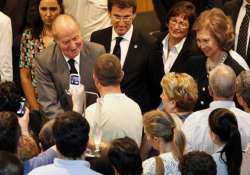Probe of deadly derailment in Spain focuses on train speed
Santiago De Compostela (Spain), July 26: By all accounts, the train was going way too fast as it curled around a gentle bend. Then in an instant, one car tumbled off the track, followed by

Santiago De Compostela (Spain), July 26: By all accounts, the train was going way too fast as it curled around a gentle bend. Then in an instant, one car tumbled off the track, followed by the rest of the locomotive, which seemed to come apart like a zipper being pulled.
The derailment sent pieces of the sleek train plowing across the ground in a ghastly jumble of smashed metal, dirt and smoke.
But a day after Spain suffered its deadliest rail disaster in decades, which killed 80 people and maimed scores of others, one question surpassed all others: Why was the train moving so fast?
Investigators opened a probe on Thursday into possible failings by the 52-year-old driver and the train's in-built speed-regulation systems.
Experts said one, or both, must be at fault for the disastrous Wednesday night crash of the train that was carrying 218 passengers and five crew members to Santiago de Compostela, a destination of Catholic pilgrimage preparing to celebrate its most revered saint.
Instead, this stunned city of nearly 100,000 converted its sports arena into a shelter for the dead and the grieving.
“All Spaniards feel the pain of the families,” said Spain's head of state, King Juan Carlos, as he and Queen Sofia met hospitalised survivors of the crash 4 kilometres south of Santiago de Compostela. The royal couple dressed in funereal black.
“For a native of Santiago like me, this is the saddest day,” said Prime Minister Mariano Rajoy, who toured the crash scene and declared a national three-day mourning period.
The regional government of Galicia, in northwest Spain, said 94 people remained hospitalised, 31 of them in critical condition, including four children. The U.S. State Department said one American died and at least five others were hurt but cautioned that those figures could be revised upward.
The American victim was identified by the Diocese of Arlington as Ana Maria Cordoba, an administrative employee from northern Virginia. She and her husband and daughter were travelling to visit her son, who had completed the pilgrimage to Santiago de Compostela, according to Catholic News Service, a division of the U.S. Conference of Catholic Bishops.
Many victims suffered severe burns as the train's diesel fuel ignited a fire that caught some passengers trapped in mangled upside-down carriages. Emergency officials took DNA samples from the most heavily burned or the unconscious in an effort to identify both the living and the dead.
The derailment sent pieces of the sleek train plowing across the ground in a ghastly jumble of smashed metal, dirt and smoke.
But a day after Spain suffered its deadliest rail disaster in decades, which killed 80 people and maimed scores of others, one question surpassed all others: Why was the train moving so fast?
Investigators opened a probe on Thursday into possible failings by the 52-year-old driver and the train's in-built speed-regulation systems.
Experts said one, or both, must be at fault for the disastrous Wednesday night crash of the train that was carrying 218 passengers and five crew members to Santiago de Compostela, a destination of Catholic pilgrimage preparing to celebrate its most revered saint.
Instead, this stunned city of nearly 100,000 converted its sports arena into a shelter for the dead and the grieving.
“All Spaniards feel the pain of the families,” said Spain's head of state, King Juan Carlos, as he and Queen Sofia met hospitalised survivors of the crash 4 kilometres south of Santiago de Compostela. The royal couple dressed in funereal black.
“For a native of Santiago like me, this is the saddest day,” said Prime Minister Mariano Rajoy, who toured the crash scene and declared a national three-day mourning period.
The regional government of Galicia, in northwest Spain, said 94 people remained hospitalised, 31 of them in critical condition, including four children. The U.S. State Department said one American died and at least five others were hurt but cautioned that those figures could be revised upward.
The American victim was identified by the Diocese of Arlington as Ana Maria Cordoba, an administrative employee from northern Virginia. She and her husband and daughter were travelling to visit her son, who had completed the pilgrimage to Santiago de Compostela, according to Catholic News Service, a division of the U.S. Conference of Catholic Bishops.
Many victims suffered severe burns as the train's diesel fuel ignited a fire that caught some passengers trapped in mangled upside-down carriages. Emergency officials took DNA samples from the most heavily burned or the unconscious in an effort to identify both the living and the dead.